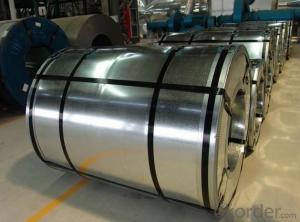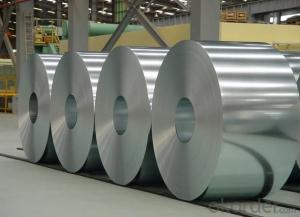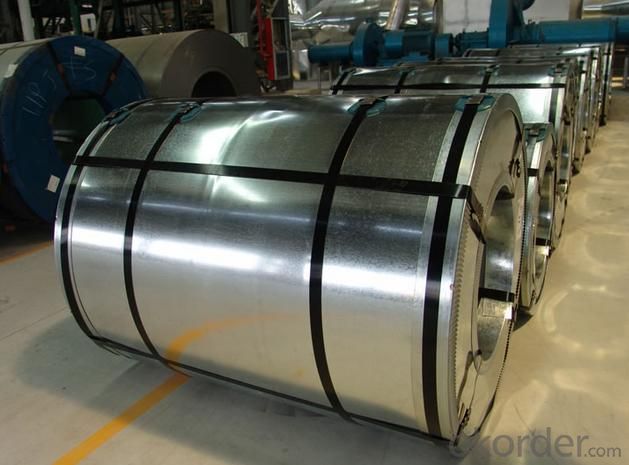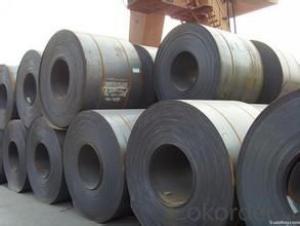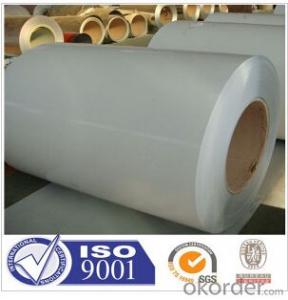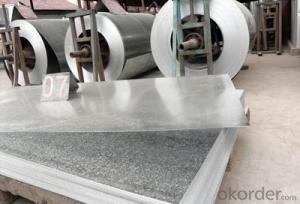Az150 ASTM A792 Aluzinc Galvalume Steel Coil
- Loading Port:
- Tianjin
- Payment Terms:
- TT OR LC
- Min Order Qty:
- 25 m.t.
- Supply Capability:
- 10000 m.t./month
OKorder Service Pledge
OKorder Financial Service
You Might Also Like
Description Basic Info.
Model NO.:AZ150 ASTM A792 Aluzinc Galvalume Steel Coil
Surface Treatment:Galvalume
Certification:ISO, SGS, BV, RoHS, IBR
Technique:Cold Rolled
Standard:ASTM, JIS, GB, AISI, DIN, BS
Application:Roofing,Wall,Corrugated,Structure...
Edge:Slit edge
Stock:Stock
Steel Grade:Dx51d,SPCC,SGCC,CGCC,S350gd
Name:Az150 ASTM A792 Aluzinc Galvalume Steel Coil
Thickness:0.14-3mm
Width:600-1250mm
Az Coating:40-275GSM
Surface:Oiled,Galvanized,Chromated
Spangle:Zero,Small,Big,Regular
Hardness:Full,Half
Length:1-12m,as You Request
Certificate:BV,ISO
Test:QA-QC-Mtc
Export Markets:Global
Additional Info.
Packing:Standard Export Package
Standard:0.14-3mm*600-1250mm
Origin:China
HS Code:7905000000
Production Capacity:30000 Tons/Year
Product Description
AZ150 ASTM A792 Aluzinc Galvalume Steel Coil
1. Specification:
(1), Base Metal: Cold rolled (CR)
(2), Az Coating: 40-275gsm
(3), Thickness: 0.14mm-3mm
(4), Width: 600mm-1250mm
(5), Length: In coil, According to your requirement (unit of measurement: Ton)
(6), Minimun order: 5Tons
(7), Packaging Details: Fully seaworthy export packing
(8), Price Terms: FOB, CIF, CFR, CNF
(9), Hardness: Full, half
(10), Width tolerance: ± 10mm
(11), Spangle: Zero spangle, min spangle, regular spangle, big spangle
| Item: | Galvalume Steel Coil |
| Material: | SGCC, SGCH, SPCC, SGCD, DX51D+Z, STO2Z,DX54D,DX51D |
| Thickness: | 0.14mm-3mm |
| Width: | 600-1250mm |
| Length: | 1-12m or as requested |
| Surface: | Galvalume,oiled,chromated |
| Application: | Industrial panels, roofing and siding for painting |
| Types: | Commercial / Drawing / Deep Drawing / Structural quality |
| Az coating: | 40-275g/m2 |
| Surface Treatment: | chromed / skinpass/ oiled/slightly oiled/ dry/ anti-fingerprint |
| Surface Structure: | zero spangle / minimized spangle / regular spangle/ big spangle |
| MOQ: | 5 tons |
| Payment term: | T/T, L/C |
| Packing information: | Export standard package :bundled wooden box or be required; The inner size of container is below: 20 ft GP:5.8m(length)x 2.13m(width)x 2.18m(high) about 24-26 CBM 40 ft GP:11.8m(length)x 2.13m(width)x 2.72m(high)about 68 CBM |
| Port: | Qingdao,Tianjin port |
| Delivery time: | 15-20 days,after we received your deposit |
1)REGULAR SPANGLE:
Regular spangle is also called normal spangle which is naturally formed without any additional treatment during galvanizing.
2)MINI SPANGLE:
The spangle is restrained and formed as mini spangle by reducing the lead content in the zinc liquid or by blowing the zinc powder from the equipment installed on the zinc pot.
3)EXTRA SMOOTH:
The mini spangle is further skin-passed to produce the extra smooth surface.
FAQ
1.What's your MOQ?
25MT, it is for one container.
2.Do you have QC teams?
Yeah, sure, our QC team is very important, they will keep the quality control for our products.
3. What's your normal delivery time?
Our delivery time about 10-20days for standard sizes, if you have other requirements like hardness and width ,it is about 20-40days. But don't worry ,we also try our best for the delivery time ,because time longer and our cost is higher.
4.Are the products tested before shipping?
Yes, all of our PPGI and GI was qualified before shipping. We test every batch every day.
AN> Price terms FOB, CFR, CIF Payment terms 20%TT in advance+80% TT or irrevocable 80%L/C at sight delivery time 25 days after recepit of 20% TT Remarks Insurance is all risks MTC 3.1 will be handed on with shipping documents We accept SGS certificatation test
- Q: What are the different types of steel coil cutting processes?
- Various industries utilize several different steel coil cutting processes. These processes include: 1. Shearing: The most widely used and simplest method of steel coil cutting involves utilizing a shear blade to cut the coil material into desired lengths. This can be done either manually or with the assistance of automated machinery. 2. Slitting: A process designed to cut wide coils into narrower strips, slitting involves passing the coil material through a set of circular knives that cut the steel into smaller coils or strips of the desired width. 3. Laser cutting: Renowned for its precision and efficiency, laser cutting involves using a high-powered laser to melt or vaporize the material along a predetermined path. This method is commonly employed for intricate designs or when high accuracy is required. 4. Plasma cutting: Another method of cutting steel coil involves using a plasma torch that generates a high-velocity jet of ionized gas to melt the material. Plasma cutting is known for its speed and ability to cut through thick materials. 5. Waterjet cutting: This process utilizes a high-pressure stream of water mixed with abrasive particles to cut through steel coil. Waterjet cutting is frequently chosen when the material being cut is sensitive to heat or when precision is necessary. 6. Saw cutting: A traditional cutting method, saw cutting involves using a saw blade with teeth to cut through the material. It is particularly effective for thicker materials and can be performed manually or with the aid of automated machinery. These represent just a few of the many steel coil cutting processes commonly employed. The choice of cutting method relies on several factors such as the material's type and thickness, desired accuracy, speed, and cost-effectiveness.
- Q: I felt that my nylon strings don't sound as good as steel ones. Is it okay that I replace them with steel ones, even if my guitar is classical? Thanks.
- Don't. okorder /
- Q: I bought stainless steel appliances a year ago. I have two kids who like to put their hands all over the fridge and they always leave dirty marks all over it. I bought stainless steel cleaner but it doesn't do a good enough job. Anyone know any other cleaning remedies?
- All the stainless steel cleaners I've tried are fine for polishing, but they don't clean anything. A damp microfiber towel (the kind with loops like terry cloth) does a good job. You might be able to use plain water because the cloths are so good. Or mix up some dish soap in water and wet the towel with that. You can use windex if you want something more convenient.
- Q: How are steel coils used in the production of electrical conduits?
- Several techniques are employed in the production of electrical conduits using steel coils. Firstly, the raw material for manufacturing electrical conduits is steel coils. These coils are composed of specially processed and formed high-quality steel, which is transformed into a continuous strip of considerable length. Once the steel coils are acquired, they are fed into a machine known as a slitter. This machine swiftly slices the coils into narrower strips of the desired width, which will function as the foundational material for the electrical conduits. The subsequent step involves shaping the steel strips into the desired conduit shape. This is accomplished by guiding the strips through a series of rollers and various shaping tools. Gradually, the steel strips take on the round or rectangular shape of the conduit as the rollers exert pressure and manipulate the strip until it reaches the desired form. After the shaping process, the ends of the steel strips are fused together to create a seamless conduit. This welding procedure ensures that the conduit possesses a structure devoid of any seams, a vital characteristic for its functionality and durability. Once the conduits have been shaped and welded, they undergo additional processing to enhance their properties. This may involve galvanizing, whereby a protective layer of zinc is applied to the conduits to shield them from corrosion. This additional layer significantly prolongs the lifespan of the conduits, rendering them suitable for a wide range of electrical applications. In summary, steel coils play a crucial role in the production of electrical conduits. These coils serve as the raw material that is shaped, welded, and further processed to create the final product. The utilization of steel coils ensures that the electrical conduits are robust, long-lasting, and capable of withstanding the rigorous demands of electrical installations.
- Q: How are steel coils used in the manufacturing of pipes and tubes?
- Steel coils are used in the manufacturing of pipes and tubes by being unwound and fed into a pipe or tube mill. The steel coils are then shaped and welded together to form a continuous pipe or tube, which is further processed and finished according to specific requirements.
- Q: Why is steel a stiff material?I'm doing a project on the use of steel in the construction of skyscrapers - and obviously, for the inner steel skeleton of a skyscraper the steel support beams and girders will have to be stiff so that they don't fall apart or the building doesn't shake due to wind or other natural forces.But in my research I've found that steel (mild steel to be more exact) is ductile and malleable, meaning it can be shaped fairly easily. However, how can steel ALSO be stiff - the definition of stiffness is the tendency to withstand bending and stretching - so my question is. How can this material be BOTH ductile/malleable, AND stiff? and why? :)Thank you in advance if anyone takes the time to answer this, would be appreciated - I'll give you 10 points straight away if the answers conclusive
- To say that steel can be bent and shaped fairly easily isn't quite true. It takes multiple tons of force to do so, requiring some very heavy machinery. I think you're confusing a couple of concepts. For example the idea of elastic modulus, versus rigidity Rigidity is the ability of a structure to resist a load. That depends not only on the elastic modulus, but on the size and design of the structure or object. You can build fairly rigid structures out of wood. For example roller coasters. Even though wood has a much lower elastic modulus than steel, meaning that it takes much less force to bend and deform a given sample of wood.
- Q: days. Use your knowledge of the corrosion of steel and aluminum to predict how they would look different after a week exposed to rainy weather. Explain your prediction.
- I'd expect appearance of reddish dots or stains of rust on steel, while aluminium should stay virtually unchanged. Explanation: Both materials oxidize in natural environment because of atmospheric moist, but in very different ways. As for steel, oxidation begins as reddish dots of rust which grow and become stains. Oxidation then progresses in depth causing decay of material, compromising its strength and structural integrity.
- Q: I beat fallout 3 and i downloaded broken steel expansion. I have no idea how to get to broken steel in other words i do not know how to start playing it.
- This Site Might Help You. RE: how to start fallout 3 broken steel? I beat fallout 3 and i downloaded broken steel expansion. I have no idea how to get to broken steel in other words i do not know how to start playing it.
- Q: Hi, I have ranch style home. I would like to remove a barring wall, And leave it open it will become a 18' foot 7 inch opening , and I'm interested in installing a steel beam so that i may remove the barring wall that supporting the ceiling and rafters. My house is about 57' feet long 28' feet 7 inch wide and it is 13' feet high from the floor to the top of the roof ridge. I heard there is aluminum beams but I never heard of that, I've only heard of steel beams. I don't want to use wood. I would also like to now how much longer do i need the beam to be the opening would be 18'7 plus the extra that i would need to put on the block wall to hold the beam up, do I make it 2' feet bigger so i can have a foot on each side that would sit on a block wall. or do i need more then that.THanks for your help
- My okorder for help
- Q: How are steel coils used in the production of storage tanks?
- Steel coils are used in the production of storage tanks as they provide the necessary strength and durability required for containment and storage of various substances. These coils are rolled into cylindrical shapes and welded together to form the tank's body, ensuring a tight and secure structure. Additionally, the steel coils can be coated or treated to provide corrosion resistance, further enhancing the tank's longevity and suitability for storing liquids or gases.
Send your message to us
Az150 ASTM A792 Aluzinc Galvalume Steel Coil
- Loading Port:
- Tianjin
- Payment Terms:
- TT OR LC
- Min Order Qty:
- 25 m.t.
- Supply Capability:
- 10000 m.t./month
OKorder Service Pledge
OKorder Financial Service
Similar products
Hot products
Hot Searches
Related keywords
